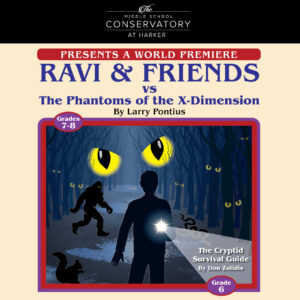This article originally appeared in the summer 2011 Harker Quarterly.
Harker has a strong reputation for producing students who excel in math and science. This tradition of success can be traced back to foundations laid in the lower and middle school curricula, which emphasize methods and hands-on learning that open the door to later growth.
These seeds of success are planted early in the youngest Harker students, the kindergarten and grade 1 students. At this level emphasis is placed on defining what science is and what scientists do. So, for three periods a week, kindergarten students are engaged in hands-on projects that, according to Michelle Anderson, who teaches kindergarten science, math, social studies and English, “are more real to kindergarten minds.” Anderson explores essential, introductory themes like “the five senses, the solar system and changes in life cycles.” One of the kids’ favorite sections is focused on life cycles, where the students are
able to observe caterpillars as they develop from their larval stages to their chrysalises and then become butterflies. These broad topics, explored through reading, activities and experiments, lay a structure for later study.
Once students have progressed to grade 2, they begin to enter into more intensive science programs. The students are learning increasingly broader topics, such as measurement (a necessity for any burgeoning scientist), water, the human body, and electricity and magnetism. These topics are taught using the Lawrence Hall of Science’s Foss curriculum, which emphasizes the key principle that science is learned through conducting experiments and understanding concepts in a hands-on manner. Katy Sommer, grade 2 science teacher, notes that Harker students “devote a large amount of time to science, four periods a week, which helps them build strong foundations.”
In grade 5 students have advanced to more complex life science topics. Here students learn about scientific method in detail and spend a substantial amount of time on essential topics such as taxonomy. At this level students continue to be exposed to real-life applications of what they learn in their textbooks. In order to associate theory learned in class into hands-on knowledge, this year’s entire grade 5 class explored the tide pools at the Fitzgerald Marine Reserve in Monterey in April. Catherine Le, grade 5 science teacher, said that her students could find many of the things in tide pools they had just finished learning about in class. Learning the characteristics of the echinoderm phylum becomes more real when a student can hold a sea star and physically observe it.
As the students enter middle school, the fundamental topics and ways of thinking that have been established begin to come into contact with the more complex scientific concepts that will be emphasized in high school and college. In grade 6 experimental design and methods of data gathering are explored through the physical sciences. At the end of the year, students are tasked with designing an experiment, conducting it and interpreting the resulting data. The students then synthesize the information into a poster board presentation.
In grade 8 students conduct three experiments in their biology classes. These experiments utilize tools to explore human physiology, allowing students to measure characteristics like lung capacity and heart rate and also track the student-designated variable of interest.
The general process of designing and conducting experiments becomes more complex as the students move from grade to grade. When considering their progress, Lorna Claerbout, K-8 science department chair, says “the learning spirals as it moves upward. Threads are repeated as students have a higher capacity to understand.”
These repeating threads, with their heavy emphasis on data gathering, critical thinking and pattern recognition, mean that Harker students are consistently recognized as exemplary. At the Synopsys Championship Fair, held March 6-7, Harker students were recognized at many levels for their outstanding work. The middle school students produced more than a half dozen award-winning projects. They were recognized for laudable work in physics, medicine, environmental sciences, biochemistry, botany and zoology subjects for both individual efforts and team submissions.
These results are but the latest in a long line of strong Harker performances in the sciences, and while the high caliber of student cannot be discounted when tracing the roots of their success, we must certainly pay tribute to where they began, in the lower and middle school science classrooms.






